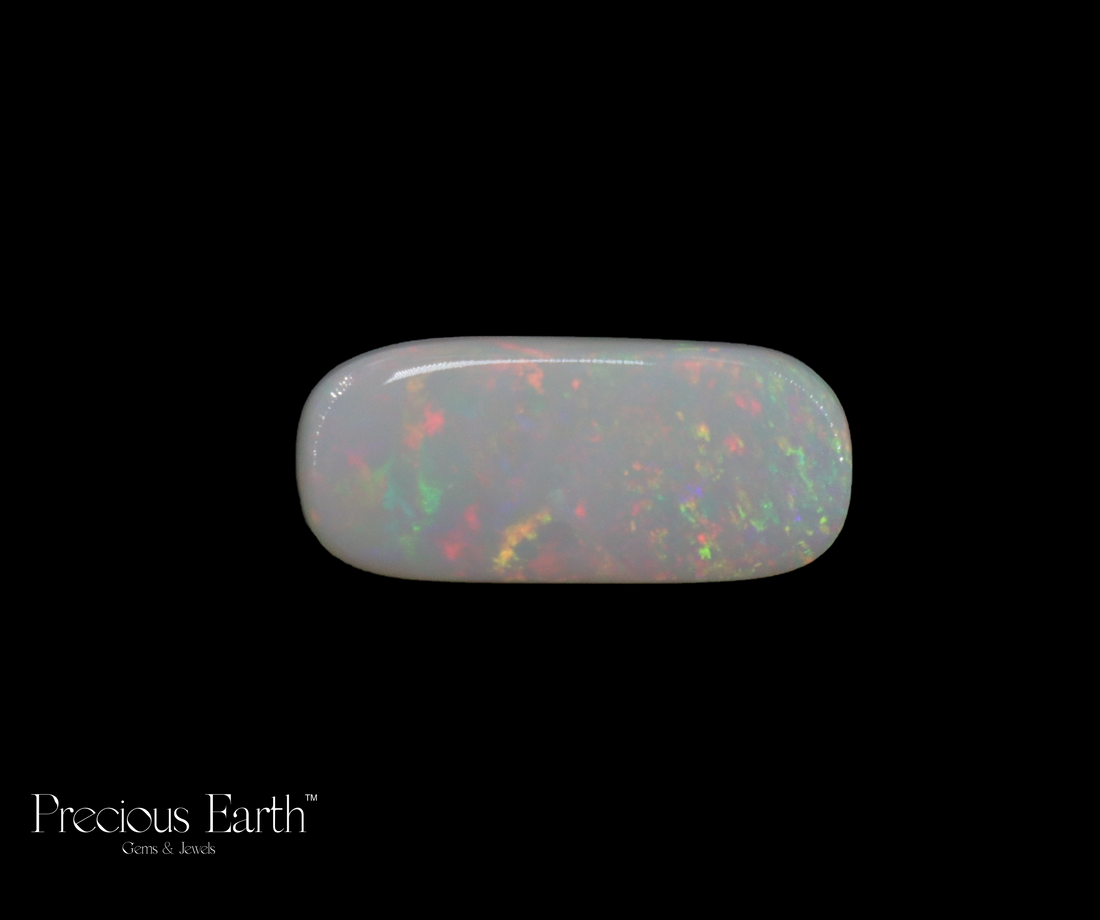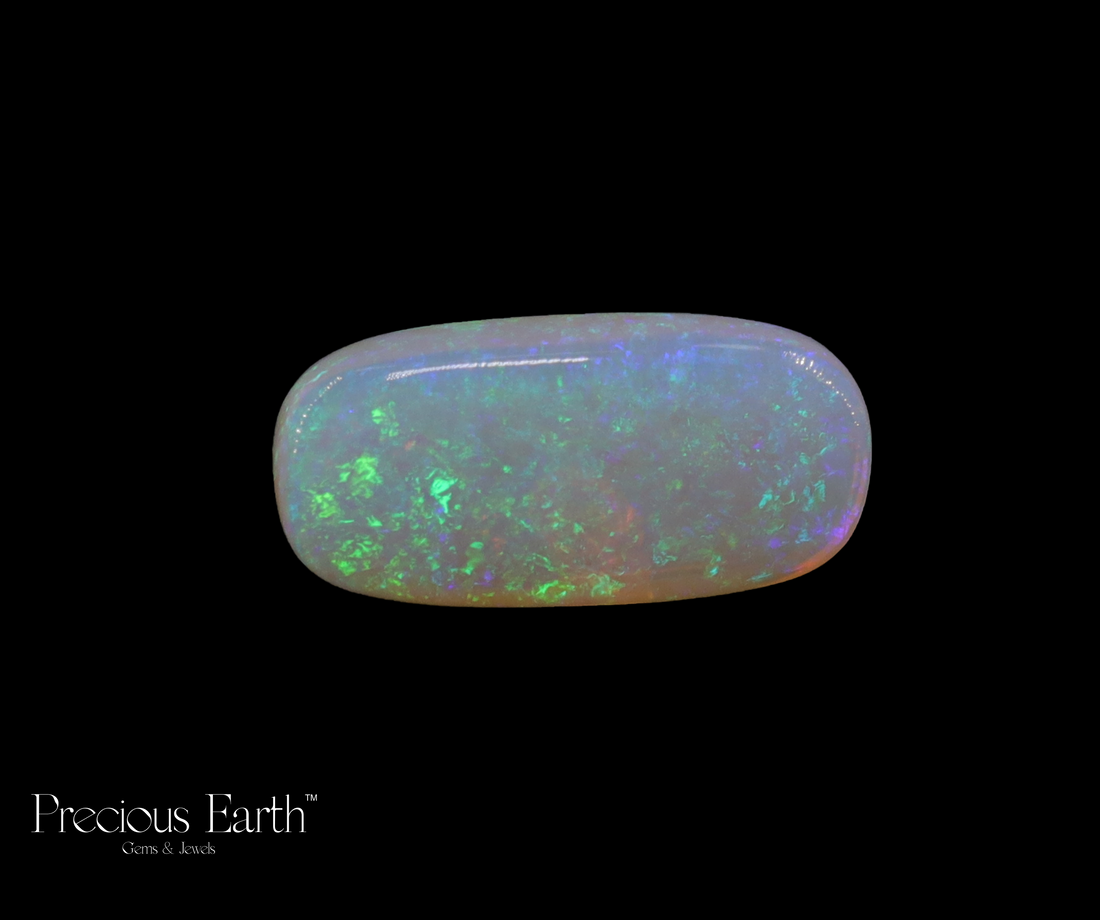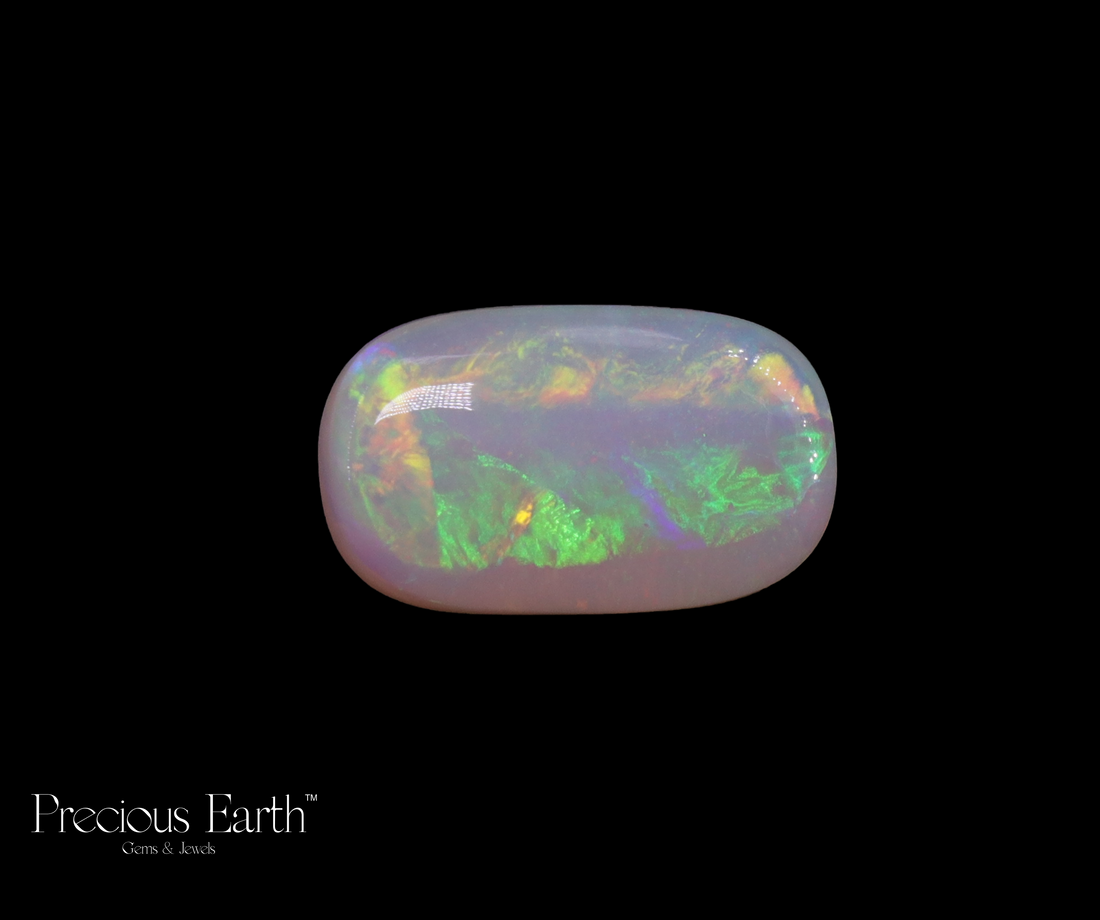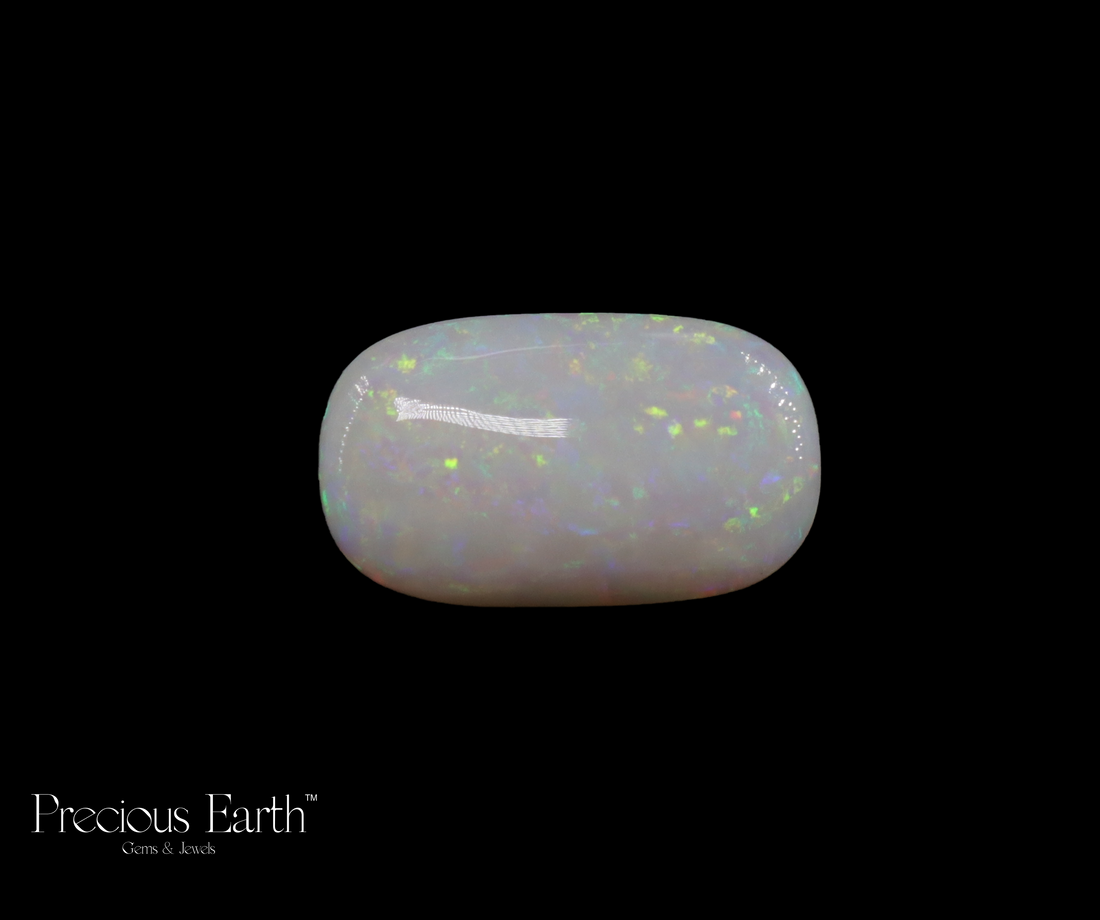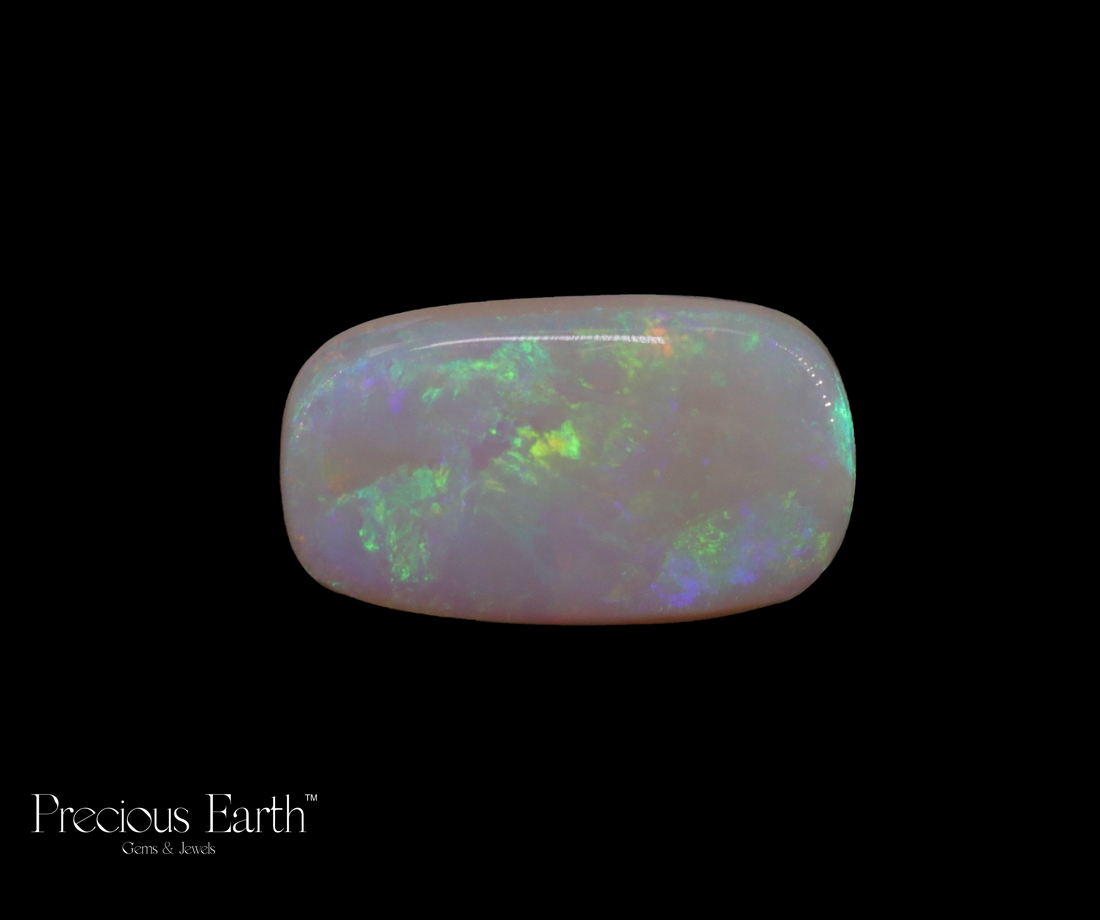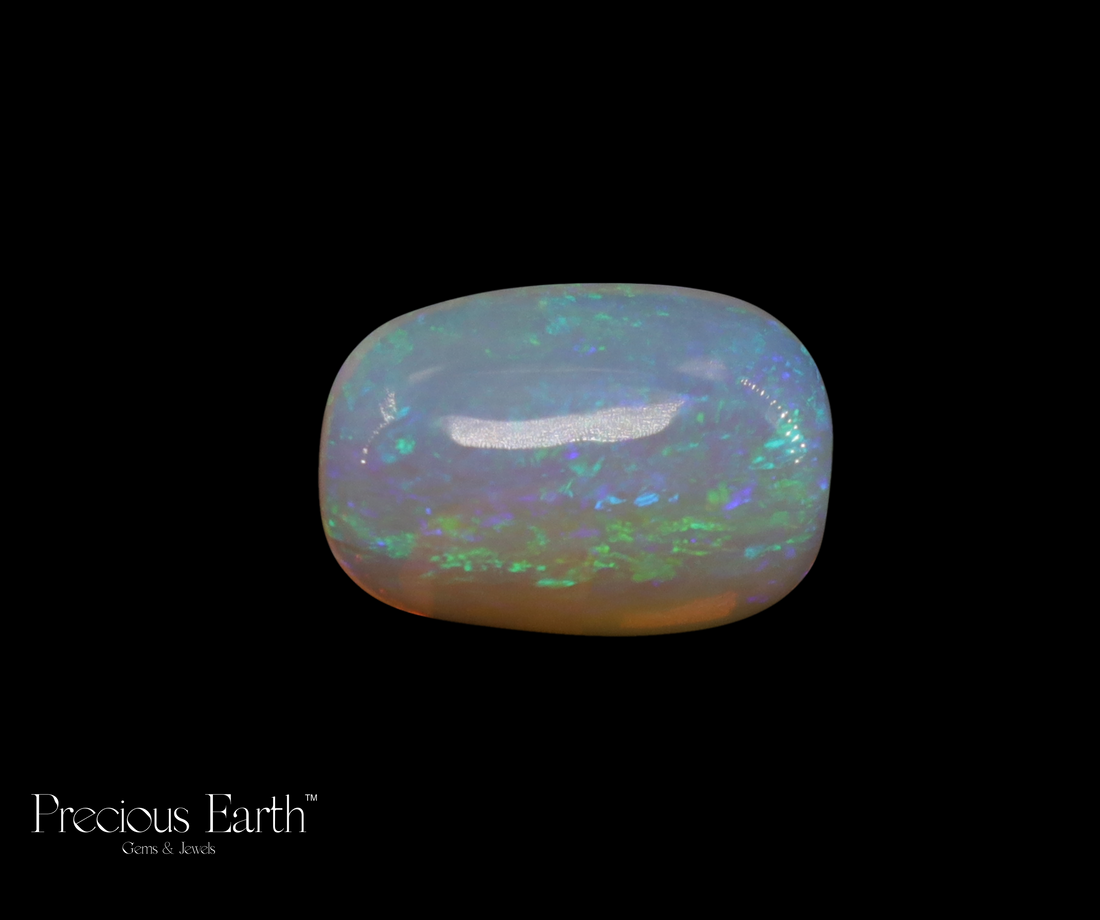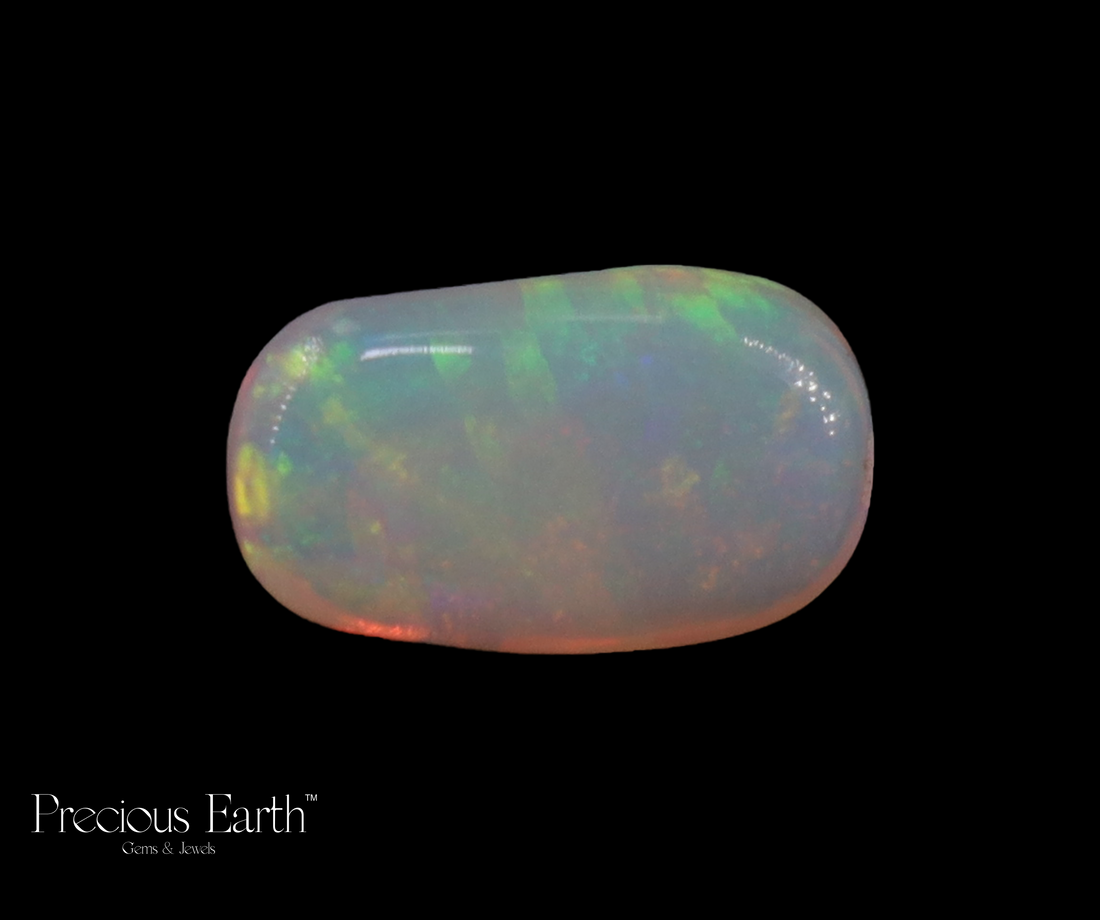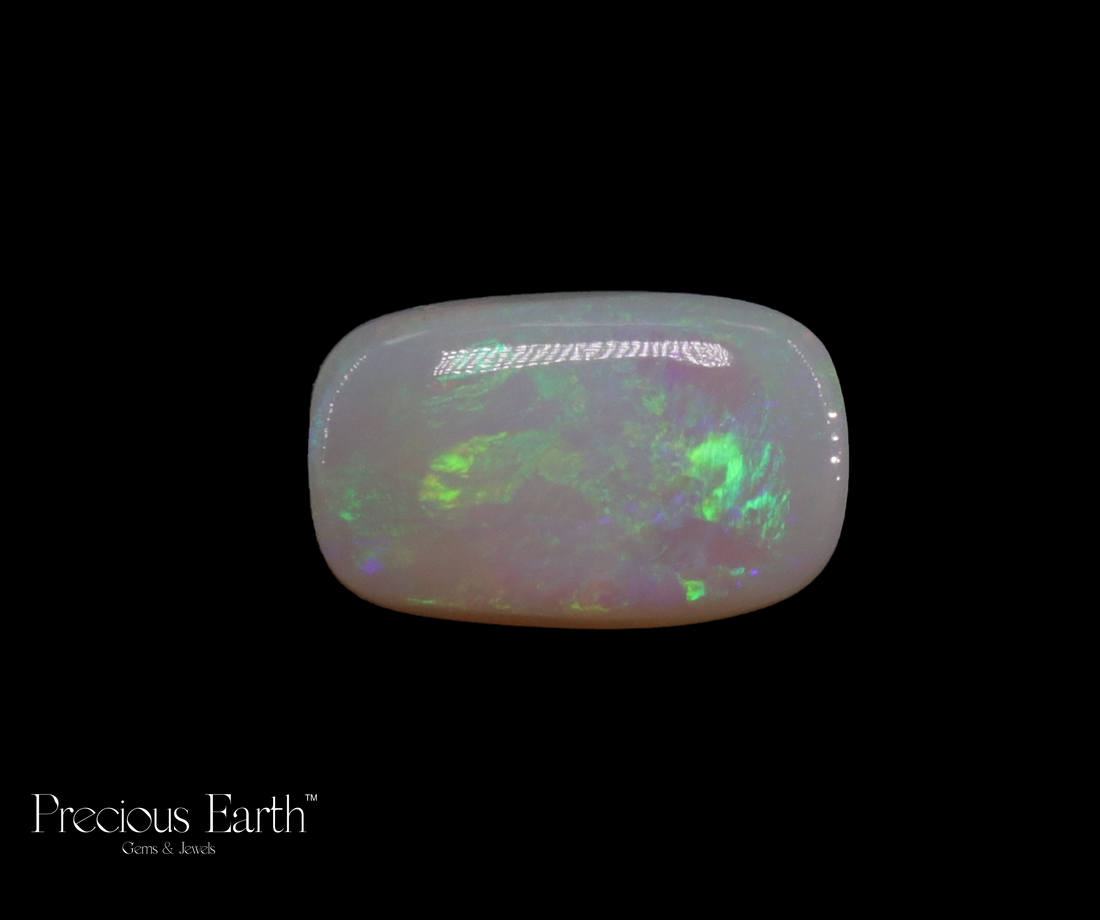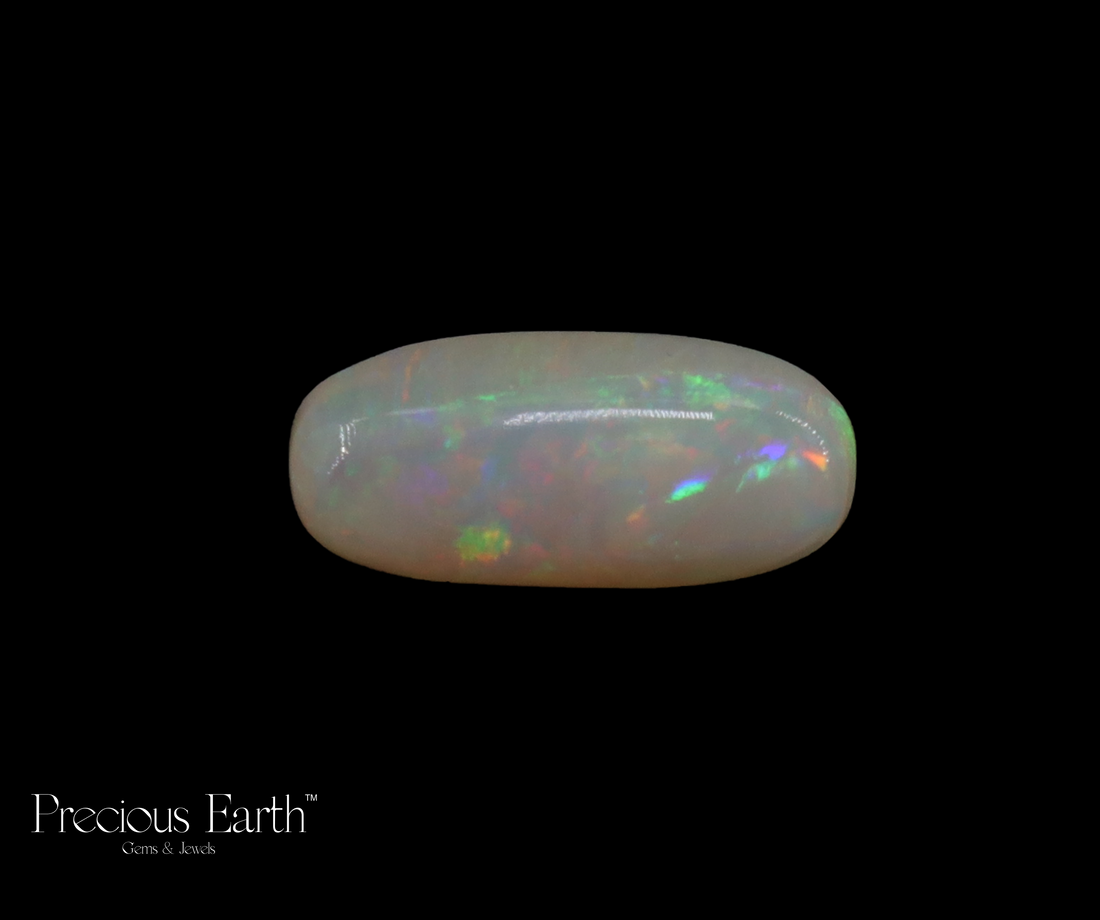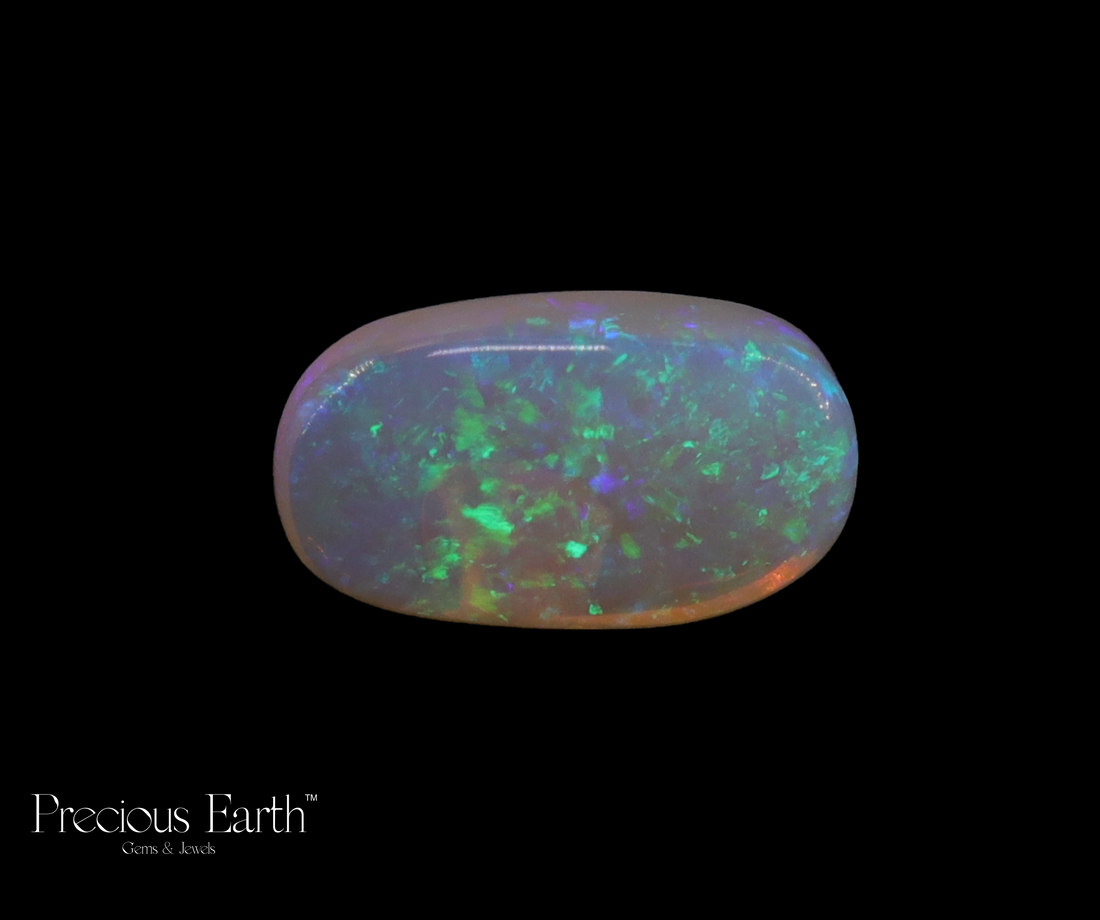This article serves as part of an ongoing series of profiles on the different varieties of precious & semi-precious gemstones. To view the entire list, click here.
Perhaps the most riveting optical phenomenon found in any gemstone, is the “play of colour” exhibited by opals. Unlike most other gemstones such as sapphires, emeralds, or rubies, the opal stone is classified as a mineraloid and not a strict mineral. This is because the opal stone is a hydrated amorphous form of silica, and unlike minerals, it does not have a specific atomic crystal structure. What is also interesting about this particular gemstone is that its water content may range between 3% and 20% of its total weight. This is highly unusual since no other gem consists of such a high quantity of water throughout its body.
Archaeological evidence suggests that Opals were first discovered in Virgin Valley, America, over 10,000 years ago. More recently, Australia has emerged as the leading source of high-quality opals. Throughout history, many cultures across the globe have attributed opals with mystical origins and extraordinary powers. In Arabic folklore, opals were believed to have descended from the sky in bursts of lightning. In the ancient Greek tradition, opals were thought to bestow the ability of prophecy upon their possessors and provide protection against illnesses. Throughout European history, opals have consistently symbolized hope, purity, and truth, serving as powerful cultural emblems.
 Rough opal stones
Rough opal stones
In this gem buying guide, we’ve compiled everything you need to know about the opal stone – including its scientific formation and occurrence, its qualities and types, and its astrological benefits.
1. Opals - Formation & Occurrence
The opal stone is truly an extraordinary gem, and displays a rather fascinating optical phenomenon, known as iridescence or “play of colour”. The formation of an opal begins when water, rich in silica, percolates through the earth's crust. This water seeps into cracks and cavities in rocks, often associated with the presence of other minerals like quartz or sandstone. Over an extended period of time, sometimes millions of years, the water slowly evaporates or seeps away, leaving behind a silica-rich gel-like substance.
As this gel consolidates and hardens, it forms the intricate lattice structure that characterizes opals. This structure is responsible for the mesmerizing play of colours observed in opals, known as "opalescence." The play of colour occurs due to the way the silica spheres within the opal diffract light, breaking it into its spectral colours. The size and arrangement of these silica spheres determine the specific colours and patterns seen in each opal. Factors like impurities and the presence of other minerals also influence the opal's colouration. The geological and chemical complexities involved in opal formation contribute to the gem's allure and make it a subject of fascination in the field of gemmology.
 Black opals are among the rarest variety of Opals (Source: GIA)
Black opals are among the rarest variety of Opals (Source: GIA)
2. What Are the Different Types of Opals?
Various types of opals are found in distinct regions across the world, each with its individual characteristics and appeal. Gemmologists generally classify opals primarily on the basis of their colour or origin. For your reference, we have listed some of the most popular types of opals below:
- White Opals: White opals are characterized by their light-to-white body colour, providing a gentle backdrop for their play of colours. They are often found in various Australian opal fields, including Coober Pedy and Mintabie. While they may not exhibit the intense play of colours seen in black or precious opals, white opals have their own subtle charm. Their play of colours can range from soft blues and greens to delicate pinks and reds. White opals are admired for their affordability and versatility in jewelry, making them a popular choice for those seeking opal's beauty without the high price tag.
- Black Opals: Black opals are renowned for their dark body tone, creating a vivid contrast with their vibrant and intense play of colours. The most prized black opals are sourced from Lightning Ridge, New South Wales, Australia. These opals are very rare, and often display deep blues, striking greens, and fiery reds against their black background. Their rarity and the mesmerizing interplay of colours make them highly sought after by collectors and jewelry enthusiasts alike. Black opals stand out for their captivating and dramatic appearance, earning them a special place in the world of opals.
 A black opal with a prominent display of its 'play-of-colour'
A black opal with a prominent display of its 'play-of-colour'
- Fire Opals: Fire opals are known for their brilliance and vivid orange to reddish-orange body colour, resembling the fiery hues of sunset. These opals are predominantly found in Mexico. While they may not display the same dramatic play of colours as other precious opal stones, their fiery hue is their defining feature. What is important to note is that often colloquially, the play of colour is called “fire” in an opal, and such opals end up being called “fire opals”. This is incorrect, and you must use context to decipher whether someone is referring to the play of colour or iridescent effect of an opal stone, or actually talking about a “fire opal” which is orange in colour, and does not usually exhibit a play of colour.
- Boulder Opals: Boulder opals are distinct for their formation within the host rock, usually ironstone. They are often found in Queensland, Australia. These opals display a natural connection between the opal and its host rock, creating visually intriguing patterns. The opal forms as thin veins or patches within the ironstone, resulting in a mosaic-like appearance. Boulder opals are admired for their earthy yet captivating look, making them a favourite for those who appreciate opals with a unique geological context.
 Boulder Opals are formed within the cracks and seams of host rocks such as Ironstone
Boulder Opals are formed within the cracks and seams of host rocks such as Ironstone
- Australian Opals: Australian opal is a broad term encompassing opals from various regions across Australia, including Lightning Ridge, Coober Pedy, and Mintabie. These opals can vary in body colour, play of colours, and characteristics depending on their origin. Australian opals, as a whole, are celebrated for their diversity, with each region contributing its unique opal varieties. They offer a wide range of options for opal enthusiasts, from the intense colours of black opals to the subtle beauty of white opals.
- Ethiopian Opals: Ethiopian opals are relatively newer entrants to the opal market. They are primarily found in the Wollo Province of Ethiopia. These opals are known for their vibrant play of colours, often resembling the colours seen in precious opals. What sets Ethiopian opals apart is their potential for exceptional colour patterns, including vivid reds, blues, and greens. They have gained popularity for their stunning and diverse colour displays, adding a fresh dimension to the world of opals.
- Doublet & Triplet Opals: In general, opals are fragile. When a thin layer of opal material is uncovered, it is usually “assembled” with different materials such as black glass, plastic, or natural common opal, which act as a protective covering to the thinner opal. Opal doublets consist of a thin slice of precious opal affixed to a dark backing material, while triplets add a clear protective layer on top of the precious opal. These opal stones are often created to enhance the appearance and durability of the precious opal. Opal doublets and triplets can be more affordable than solid opals and are known for their vibrancy and colour play. However, they are distinct from solid opals due to their composite nature and the presence of additional materials. They offer a cost-effective option for those seeking opal's beauty with added durability.
3. Where Are Opals Found?
Opals are found in various regions around the world, each with its unique geological conditions and opal types. Australia is the most renowned and prolific source of opals, producing a wide range of opal varieties. The most famous Australian opal fields include Lightning Ridge in New South Wales, known for its prized black opals; Coober Pedy in South Australia, famous for white opals and crystal opals; and Queensland, where boulder opals are often found. These Australian locations have consistently yielded high-quality opals with vibrant play of colours, making Australia a global leader in opal production.
Ethiopia has also emerged as a significant source of opal stones in recent years. The Wollo Province in Ethiopia has become renowned for its stunning Ethiopian opals, known for their intense and diverse play of colours. Other opal deposits can be found in countries such as Mexico, Brazil, Peru, and the United States. Each region's geological characteristics contribute to the unique appearance of opals found there, making opal exploration a captivating endeavour for gem enthusiasts and geologists alike.
4. Common Inclusions in Opals
Given their translucent nature and cabochon-style of cutting, inclusions in opals are often hidden to the naked eye. However, under close examination with magnification or specialized equipment, these internal characteristics can reveal fascinating details about the opal's formation history. Some common inclusions in an opal stone may include:
- Potch: Potch is common (non-precious) opal, often opaque, and lacks the vibrant play of colours seen in precious opals. It frequently forms as a matrix around precious opal.
- Bubbles: Tiny gas bubbles can become trapped within opals as they solidify. These bubbles may appear as small voids or irregularities within the gem.
- Dendritic Inclusions: Dendritic inclusions consist of branching, tree-like patterns often formed by mineral impurities or organic matter. These patterns can create intriguing and artistic designs within the opal, adding to its visual appeal.
- Matrix Opals: Matrix opals are formed within the host rock where they are found, such as ironstone. They often display a natural connection between the opal and its host rock, creating visually intriguing patterns.
 Dendritic inclusions in a rough white opal
Dendritic inclusions in a rough white opal
5. Common Treatments & Enhancements of Opals
Due to their mineraloid structure, the treatments of opal are rather different from those of sapphires, rubies or emeralds. Treatments are often applied to opals in order to enhance their appearance, stability, or even enhance their colouration. Although treatments affect the monetary value of opals, sellers often do not disclose this to their clients. As such, you must insist on a lab-certified guarantee of authenticity from your seller, that discloses any and all treatments that the opal stone you are purchasing may have undergone. Some common treatments of opals are:
- Dyeing: Dye treatments involve the introduction of coloured dyes into the opal to either intensify or modify its body colour. This process can lead to a more vibrant and uniform appearance, thereby increasing the gem's visual appeal. Dye treatments are particularly employed when the original body colour of the opal is not as striking as desired. However, buyers need to be aware of this treatment, as the long-term colour stability of dyed opals may vary depending on the quality of the dye used.
- Sugar-Acid Opal Treatments: The sugar-acid treatment is utilized to enhance the clarity and transparency of opals. It involves soaking the opal in a solution containing sugar and acid, followed by controlled heating. The chemical reaction between the sugar and acid deposits carbon on the opal – creating a darker body of the opal, which consequently results in a more prominent play of colour in an opal. Although sugar-acid treatments can significantly improve the opal's visual quality, it's essential to note that these treatments may not be permanent, and their effects can change over time.
- Smoke Treatment: Smoking is a treatment method where opals are exposed to either smoke or heat, which darkens their body colour. This treatment aims to enhance the opal's play of colours by creating a striking contrast between the darkened background and the vibrant spectral hues within the gem. Smoking treatment can make the play of colours appear more vivid and appealing, but it is essential to recognize that it can be reversible, and overexposure to heat may damage the opal.
- Dark Backings: Dark backing materials, such as black “potch” (common opal) or other substances, are often affixed to the back of opals to enhance their play of colours. This dark background serves as a contrasting canvas against which the opal's spectral colours can shine more vividly. Dark backing treatments are commonly used, especially for opals with a lighter body colour, and can contribute to the gem's overall visual appeal.
Each of these treatments plays a distinct role in altering and enhancing specific attributes of opals. Whether it's intensifying colour, improving transparency, or bolstering durability, these treatments are rather common, and every seller must disclose the treatments that the opal stone they’re selling, has undergone.
| Mineral | Non-mineral (mineraloid); Composed of Hydrated Silica |
|---|---|
| Colour Span | White, Black, Orange, Blue, Green, etc. |
| Popular Origins | Australia, Ethiopia, USA, Hungary, Peru, Mexico, etc. |
| Mohs Hardness | 5.50 – 6.50 (on a scale of 10) |
| Common Treatments | Smoke treatment, Sugar-Acid treatment, Dyeing |
| Birthstone | October |
Opals - A Quick Snapshot
6. Evaluating the Quality of an Opal
Evaluating the quality of an opal requires a careful assessment of several key factors. Opals are renowned for their captivating play of colours, and their overall value is determined by the interplay of the following factors:
- Play of Colour: The play of colours is the most defining characteristic of opals. It refers to the vibrant and shifting spectrum of colours seen when the opal is viewed from different angles. High-quality opals exhibit a vivid and extensive play of colours, with intense hues and a wide range of colour patterns.
- Base Colour: The body colour of the opal, which can range from white and light grey to black, influences the intensity of the play of colours. Black opals are highly prized for their dark body colour, which provides a striking contrast to the colours. White opals with a scintillating play of colour are also highly valued.
- Clarity: The clarity and transparency of opal stones vary, with some opals being opaque and others translucent or even transparent. Transparent opals often command higher prices due to their clarity and brightness.
- Cut: Opals come in various shapes, with oval and round being the most common. The choice of shape should maximize the display of colours. The opal's cut is essential, as it should be executed to reveal the best play of colours while ensuring a smooth, polished surface.
- Origin: Opals from renowned locations like Lightning Ridge in Australia are often more valuable due to their historical significance and the quality of opals produced there. Other origins such as Ethiopia or Peru have their own distinct characteristics, but Australian opals are regarded as the best.
- Treatments: Understanding any treatments applied to the opal is essential. Some treatments, like smoking or backing, can enhance the opal's appearance but may not be permanent.
7. How Much Do Opals Cost?
The price of an opal stone is influenced by several key factors (as explained above), including its origin, colour, clarity, play-of-colour, shape, and carat weight. Additionally, the supply and demand dynamics in both Indian and international markets play a significant role in determining opal prices.
Australian opals, known for their exceptional quality, can range in price from $25 per carat to $200 per carat, depending on factors such as size, play of colour and overall quality. Plain white opals, without any play of colour, are cheaper and can cost about $5 per carat. Ethiopian opals can cost between $15 and $100 per carat.
For a more detailed understanding of opal prices and to explore specific options, we recommend connecting with our knowledgeable gem experts who can provide comprehensive guidance tailored to your preferences and requirements.
8. Opals in Astrology
Opals hold a distinctive and intriguing place in the realm of astrology, known for their celestial connections and spiritual significance. In astrological contexts, opals are often associated with the mystical power of Venus, a celestial body that exerts a profound influence on human emotions and love. Opals are considered the birthstone for October, making them particularly significant for individuals born during this time. These captivating gemstones are thought to bring about transformative energies, fostering emotional balance, enhancing intuition, and guiding individuals on a path of self-discovery and enlightenment.
In astrology, opals are believed to be especially beneficial for those born under the signs of Libra, Scorpio and Pisces, as these signs are thought to resonate with the energies of Venus. The opal's connection with Venusian energies is said to enhance emotional well-being, increase sensitivity to one's inner self, and promote a sense of inner calm. Wearing opals is believed to aid in dispelling negative emotions, soothing turbulent thoughts, and facilitating a deeper connection with one's emotional core.
 Opals in Astrology
Opals in Astrology
In general, opal stones are associated with a range of metaphysical and astrological benefits, including:
- Love & Relationships: Opals are often associated with promoting harmony and love in relationships. They are believed to enhance marital bliss, deepen emotional connections between partners, and encourage open communication and understanding.
- Financial Prosperity: Opals are thought to attract financial prosperity and abundance. They are believed to bring about opportunities for financial success and stability, making them a symbol of good fortune in matters of wealth and career advancement.
- Health: Opals are associated with physical and emotional well-being. They are believed to have a positive impact on one's overall health, helping to alleviate stress, anxiety, and other emotional imbalances. Opals are also thought to enhance physical vitality and boost the immune system.
- Relaxation: Opals are known for their calming and soothing energies. They are believed to promote relaxation, reduce restlessness, and induce a sense of inner peace. Opals are often used in meditation practices to facilitate a tranquil state of mind.
- Emotional Balance: Opals are often regarded as stones that promote emotional balance and harmony. Their soothing energies are believed to alleviate stress, anxiety, and emotional turbulence, allowing individuals to achieve a state of emotional equilibrium.


